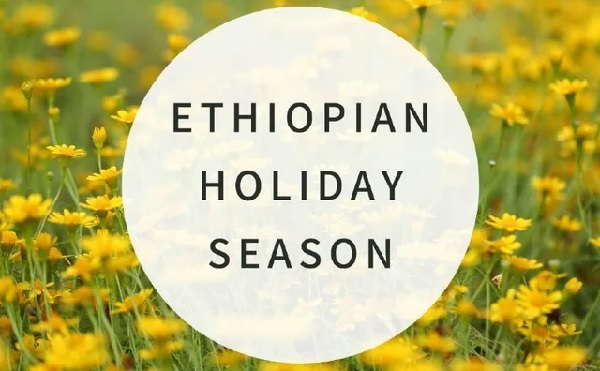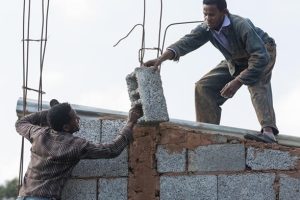
BY SOLOMON WASSIHUN
I cannot guess what inspired Antonio Vivaldi to write his thrilling music, The Four Seasons. But I can well imagine that the Ethiopian composer Ashenafi Kebede was inspired by the various and awe-inspiring ways Ethiopians celebrate life during the two great festive seasons. The simultaneous changes in weather and landscape that occur at these times may serve as an additional source of inspiration for him to compose such timeless pieces as the Shepherd’s Flute.
The seemingly endless plains and the hills, which were covered with a carpet of seedlings, have lost their green color and turned yellow due to the remains of the dried leftovers after the harvest. Whether in the highlands or the lowlands, wherever place you venture into, you would see the yellow plains, punctuated by the dome-shaped piles of the gathered harvest that looks like miniatures of the hills hanging on the horizon.
Despite whatever being is said on the radio and the social media, the seasonal sequences of the weather and the yearly cycle of the social functions would continue unperturbed. We are now near the end of the second major holiday season of the year. The first is during the months of September and October when the major holiday are celebrated including New Year’s Day, Meskel and Irrecha. The second holiday season started early last month with the celebration of the Orthodox Christmas day on 7 January.
The second holiday season reaches a fever pitch with the celebration of Timket, the European equivalent of Epiphany with colorful street religious and cultural processions held across the nation during the later dates of January. And the second holiday season would continue through February until Lent with minor religious and cultural events held in specific regions of the country where hundreds of pilgrims from home and abroad travel to and congregate.
The Gedeo peoples who are mainly residing in the Gedeo Zone of Southern Peoples Nations, Nationalities, and Peoples State held a huge celebration during this holiday season to mark a New Year [Deraro] according to their traditional calendar. Besides in another zone of the same region, Gamo people celebrate Choye Meskela while the Maale and Baskato people celebrate their respective New Year and thanksgiving holidays during this festive season.
Up in the north, in the Amhara State, the Agew Awi’s annual and cultural horse riding equestrians’ festival has been held a few days ago. And similarly, a few days later at the beginning of February, the town of Debre Tabor in South Gondor Zone hosted a magnificent and colorful horse galloping event. This captivating yearly event is dedicated to the St. Merqorios and hence known as Merqorios horse galloping [equestrian] event and gathers hundreds of thousands of spectators across the region and beyond.
The Astereyo Mariam: the Festivity commemorating the death of St. Mary, and celebrated by both the Orthodox and Catholic Christian laities has been observed in a special yearly gathering held in the Ambassel district in North Wollo Zone of Amhara region in the presence of hundreds of thousands of pilgrims that came from all corners of the nation.
So, there are so many celebrations that are observed on a national and local level during this holiday season. This is not just a coincidence. At this time of year, the barn is fuller, the cattle are fatter, and the farmers are less busy and have reaped the produce they have been toiling for months, and feel jubilant on the achievements of their back braking field work.
The cereals, coffee, fruits, honey, live stocks etc, most of the farming products are more available, both in quality and quantity. With the majority of the Ethiopians population being a farming community, most of them are economically more able this time of the year to celebrate holidays more lavishly.
This is the time when many rural households’ kitchen is busy. And the farmer’s coat unusually makes a little sound when it fell on the ground because of the few coins it made by selling some of the grains he produced. It is the proud and jubilant time of the year when he can afford to buy a new shoe for himself, a skirt for his wife, and a pair of pants for his kids.
This season is a time of brief affluence not only to the farmers, but also to business people too. It is time for the demand for consumer good spikes, and the business people from street hustlers up to the whole sellers make a huge some of profit.
And of course, the weather is balmy, ideal for extended outdoor activities. The day is bright and sunny with mild temperatures. And the night’s cold breath is rather relaxing rather than shivering, it is naturally illuminated by a bright full moonlight hanging on a luminous star-studded sky.
The holiday seasons are not entirely dedicated to religious or faith-based celebrations. It is also the preferred time to hold such major social functions like the formation of a new household and a family which is the building block of a society. The months of January and February are described by some as the major wedding season both in town and the countryside which is followed by the second wedding season that falls in the later days of April after the end of the major fasting season and celebration of Easter.
In the countryside, the sound of the wedding drums and the accompanying wedding hymn of girls and boys would be heard from every direction. Youth dressed in the traditional clothing of various Ethiopian ethnic groups flood the streets ululating with joy. In cities, the roads would be blocked by the huge tents that are venues of the lavish wedding ceremony, and a long column of decorated cars fan the air of jubilations with honking.
The holiday season is the time of the year when people get together with their loved ones and neighbors, congregate to celebrate life, thank their Gods, and congratulate themselves for making it to another year. Unconfirmed reports indicate that record number of Ethiopian diasporas visit their homeland during this holiday season. Ethiopians have several religious, cultural, and historical holidays to take a brief break from the constant struggle to make ends meet, and time and again reinforce their social and religious bonds as a community or citizens.
Irrespective of their religious and cultural identity, Ethiopians take their holidays seriously and celebrate with all devotion and enthusiasm. Whichever corner of the world they may be, no matter how small in number, Ethiopians always find a way to come together and celebrate their holidays in keeping with the manner, norms, and rituals of their ancestors.
Earlier this month Ethiopian communities residing in Los Angeles and surrounding areas celebrated Timket. Even though they can not celebrate the day on the exact date of celebration, [Jan.19] due to several inconveniences, they manage to celebrate the holiday and pass on the spirit of the holiday to their children and grandchildren who are living in foreign culture a thousand miles from the land of their ancestors.
The Ethiopian holiday celebration does not know religious and ethnic boundaries. For instance, Christians join their Muslim neighbors to celebrate the Eid al-Fitr feast, and Muslims join their Christian neighbors to enjoy the Easter feast and the Epiphany outdoor processions. The unique features of the holiday season in Ethiopia that reflect the togetherness of Ethiopia as a people of one nation are quite amazing and worthy of being a subject of fascination and research for foreign scholars.
The Ethiopian Herald February 12/2013





